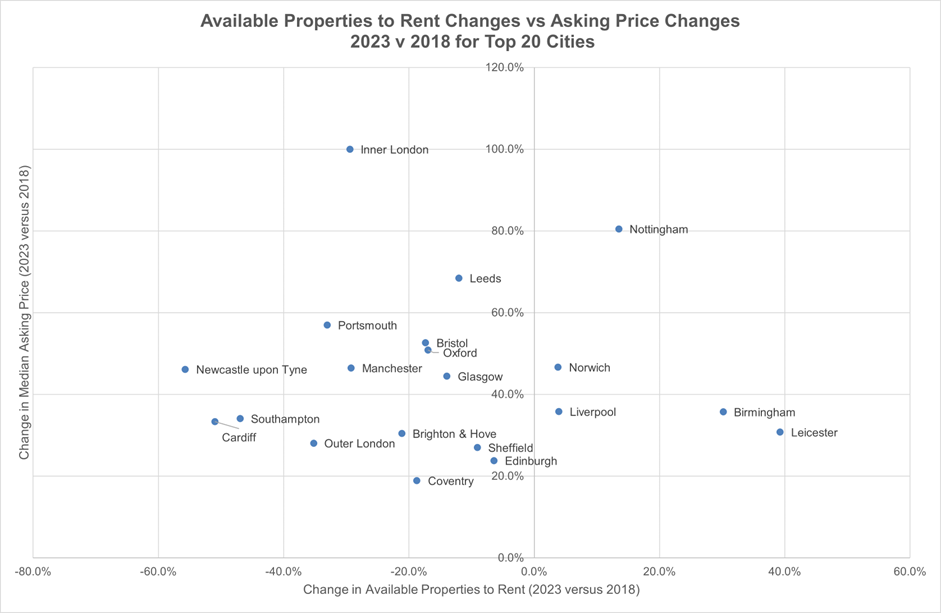In this blog we discuss the issues around recent rent rises, median rental prices and variations in rents across the UK. We look at the causes for the significant rental increases seen in the last 12 months specifically and take a broad look at the whole rental market since 2018.
RISING DEMAND DRIVES UP RENTAL PRICES
In the UK’s biggest cities, the availability of rental property stock is having a profound effect on property prices. As demand for rental properties has increased, there has been a corresponding decrease in the number of available properties to let on the market. A perfect storm, in other words, has resulted in an increase in rental prices as competition for available rental properties has grown.
There are several reasons and contributing factors to the rising rental demand. A reduction in the volume of properties for sale has meant home hunters are turning to the rental market. Property prices increased at extraordinary speed and levels during and after the pandemic which meant that many first-time buyers were forced to rent instead of buy.
The sudden increase in the cost and availability of mortgages after the Truss mini budget made it difficult for many people to afford to buy property, or even stay in their existing homes with rocketing mortgage repayments for those outside fixed rate agreements. Additionally, the instability of the economy and pressures of the rising cost of living left many people unable or reluctant to commit to a mortgage. Renting offers flexibility which can be attractive to people who are looking for short-term accommodation or those who are uncertain about their future.
The skyrocketing rental demand is causing landlords to increase rent. Inflation is another factor driving up rental prices as landlords cope with the costs of living, maintenance, and repair costs. Finally, an increase in property values overall is likely to result in escalated rental prices. As we know, the UK market has experienced unusually high rises in property prices since 2020.
AVAILABILITY OF RENTAL PROPERTIES AND RENTS ACROSS THE UK
50 out of the 70 cities in the UK have fewer properties available to rent than this time last year. An even larger majority, 62 out of the 70 cities, experienced median rental price increases. In 40 cities, rental price increases were above 10% in the last year and prices in Inner London rose by an eye-watering 30% in the last year.
Looking at the UK’s top 20 cities, 12 cities had fewer properties available to rent in March 2023 compared to March 2022. Coventry was the only city where prices went down during the same period.
The situation has been exacerbated by the fact that the construction of new homes has not kept pace with demand. This is particularly true of London, where the lack of available housing has put a significant strain on the housing market. The result is that people are paying more for fewer properties.
MEDIAN RENTAL PRICES ACROSS THE UK
We can conclude that although the rental prices have significantly risen, the availability of properties to rent has fallen. So, let’s look at what this means for median rental prices and the number of properties available to choose from in a few cities across the UK.
The median rent is the rent value that is the mid-point value of the rent samples. There are several reasons to use median rents as a measure in this scenario, the main one being that it is significantly less affected by outliers (for example a £12,000 a week property in London affects the average rents) and the fact that it is more realistic in terms of what tenants would be paying.
We have cut London in two and measured Inner and Outer London effectively as two cities. The reason for this is that they are radically different. In fact, you could treat Central London and Prime Central London differently as well, but we have not done that in this case.
We have taken measurements for March 2023 against 2022 and then assessed a like-for-like basis back to 2018 so, a five-year history. March 2020 is excluded given that the first lockdown arrived in the third week of that month.
We looked at the following cities in the UK:
● Brighton & Hove
● Bristol
● Cardiff
● Coventry
● Edinburgh
● Glasgow
● Leeds
● Leicester
● Liverpool
● London Inner
● London Outer
● Manchester
● Newcastle
● Norwich
● Nottingham
● Oxford
● Portsmouth
● Sheffield
● Southampton

Key observations
● The level of properties to rent has dropped by 7.3% in the last year and a massive 29.4% in the last five years.
● The median price pcm to rent a property has increased by 30% in the last year and 100% in the last 5 years.
● 13 out of the 20 cities have seen a reduction in available properties to rent in the last year.
● 15 out of the top 20 cities have fewer properties available to rent in 2023 than they did in 2018.
● After Inner London and Outer London, Leeds has seen the highest rental increase at over 26% year on the year 2023 / 2022 and a staggering 68% since 2018. The median asking price rents are £1,095 pcm.
● Cardiff follows in third position with a 22% rental increase since 2022; 33% since 2018 and a median asking price rent of £1,100 pcm.
● Only Coventry has experienced a reduction in median rental prices in the last year and 19 out of 20 cities have had price increases.
● There are currently 58,392 properties to rent in Inner London. These properties have a median price of £2,600 per calendar month.
WHAT DOES THIS MEAN FOR PEOPLE IN THE PRIVATE RENTAL SECTOR?
People renting property are paying more in rent than they did a year ago, except for Coventry, and have fewer properties to choose from. This can be seen as good news for landlords who are able to pick from a larger pool of tenants likely prepared to pay higher rents. It’s not, however, welcomed news for tenants who must accept market forces - higher rents - with fewer properties to choose from.
Not only do tenants face higher rents but they must also balance the growing demands of the rising cost of living. According to the Office for National Statistics (ONS), the median household disposable income in the UK was £32,300 in the financial year ending 2022. The median rent price now across the UK is now £950 pcm. This means that the average person renting the average property is paying 35% of their net income in rent.
In London, the median household disposable income is £41,900 and the median rent is £2,400pcm. This means that the average person renting an average property in London is paying 69% of their net income on rent, an unaffordable amount for most. If you compare these median rental prices to the housing allowances at a local authority level, nearly all of them are below the median rents for a property that is currently available.
In conclusion
On the face of it, landlords benefit from rising rents. However, rising inflation, interest rates and living costs of course affect everyone, including landlords who are likely to also be negatively affected by increases in mortgage repayment rates for their property investment. Indeed, this is one of the reasons why many landlords have had to increase the rents they charge.
Letting agents should give due consideration to the challenges facing the private rental sector now and demonstrate a sense of understanding and empathy when dealing with landlords and tenants around aspects such as terms and conditions and rent renewals.




-1.png?width=800&name=SOLD%20(1)-1.png)